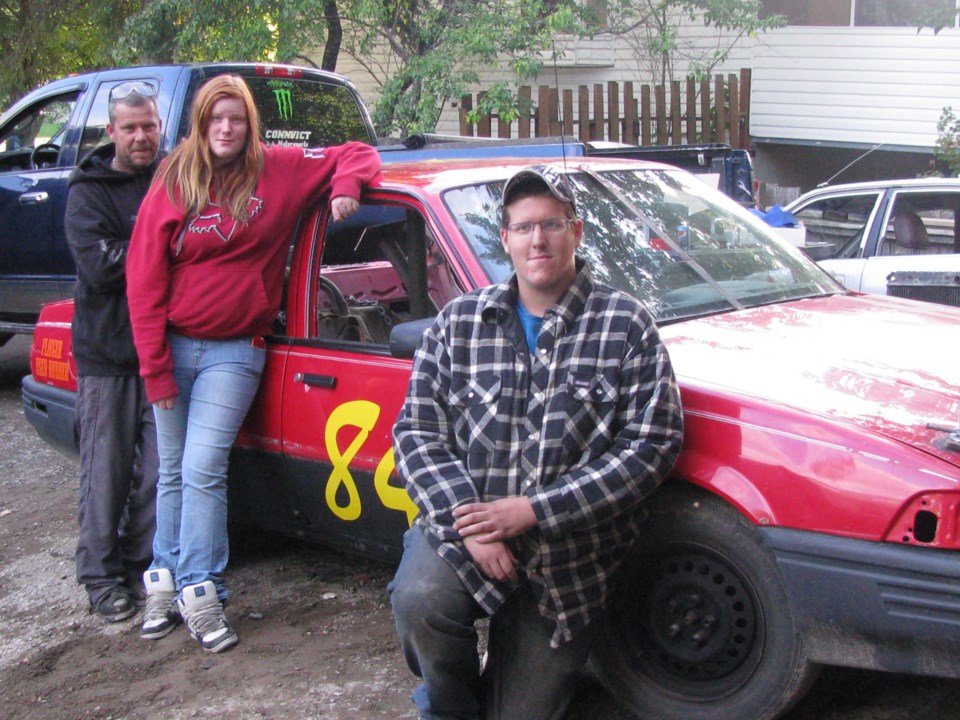Kelly Pringle is preparing to take her first spin behind the wheel.
"I've never driven in my life," says the 16-year-old wannabe hit-to-pass driver, watching her dad and brother build her four-cylinder car Friday. "I feel safer in a race car than I do in a normal car."
But, as each decal goes onto her number 84 car the Kelly Road secondary school student found her stomach getting queasy.
"It's kind of scary, because you're getting hit hard," says Kelly.
If her nerves don't keep her out of the driver's seat, Kelly will take part in the final hit-to-pass weekend of the season at PGARA Speedway Park today and Sunday.
When her dad Ron first brought home the little red car, sibling rivalry compelled Kelly to claim it.
"My dad got my brother a car and I said, 'That's my car,'" she says.
Ron Pringle, a former PGARA racer of mini-stock and thunder classes, says he had no problem setting his kids up with the hit-to-pass cars.
"The kids just wanted to do it and I figured it was better for them to be out there playing around than on the streets playing around," said Ron. "I thought we'd give it a go and try and see what it's like."
The four-cylinder cars are more economical than the bigger versions, says Ron. They are also smaller, which makes them easier to drive, plus they're easier to find and it's simpler to find parts.
Ron says if a person is committed to building a hit-to-pass car they can build one in a matter of days.
"It takes me a long time," he laughed as he and son Branden, 19, worked to get the cars ready for Friday night. "But if you get working hard on them you can have them done in three or four days. [Working] a few hours a night; just make sure you get safety equipment and everything is good with the piping, doors and concrete."
Despite Kelly's lack of driving experience, Ron says, he has no qualms about sending her out onto the race track.
"I don't let her drive on the road or even in a parking lot," says Ron. "But, once all the safety equipment is in [the hit-to-pass car] it's good."
This weekend's races are experimental in that it's the first time four-cylinder cars are being used; normally it's six- or eight-cylinder cars. PGARA's busiest weekend of the racing season will see three races for the four-cylinder cars of six, 12 and 30 laps.
Aaron Conn, a member of the PGARA board of directors and the chief in charge of legalities and safety inspections of each of the cars on race day, says getting younger drivers involved at the Speedway is important.
"We're hoping it's going to be a stepping stone for the hornets [beginner class] and minis so it can grow the other classes out at the race track," says Conn. "And this way we get a lot of younger people involved. What Ron is doing is a great thing here, trying to introduce younger kids, which will let us keep PGARA going for quite a few generations. That's what I'm hoping for."
Conn says the hit-to-pass races help young drivers learn how to control a vehicle.
"It gives them car control and teaches them how to handle a car in circumstances like wet tracks, getting spun out and stuff like that," says Conn. "Hopefully, it transfers to driving on the street with car control."
Safety is imperative, says Conn, adding underage drivers need permission from their parents.
"The way I look at it is safety's first and then we'll worry about the rest of the stuff later," says Conn. "We all got to go to work on Monday and that's the main thing we look out for."
The hit-to-pass races go today at 7 p.m. and Sunday at 2 p.m.



.png;w=120;h=108;mode=crop)